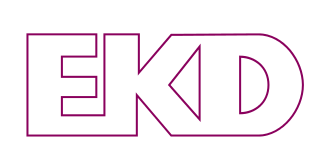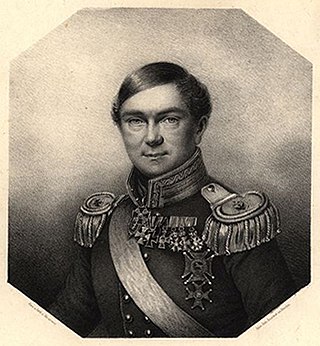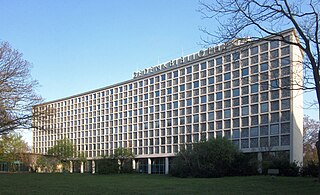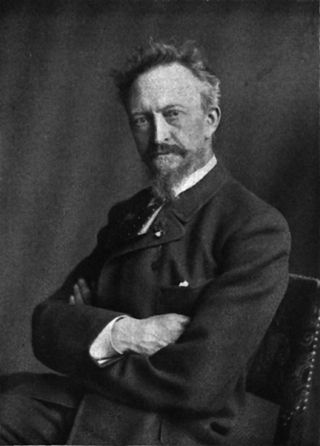
Berlin is the capital and largest city of Germany, both by area and by population. Its more than 3.85 million inhabitants make it the European Union's most populous city, as measured by population within city limits. The city is also one of the states of Germany, and is the third smallest state in the country in terms of area. Berlin is surrounded by the state of Brandenburg, and Brandenburg's capital Potsdam is nearby. The urban area of Berlin has a population of over 4.5 million and is therefore the most populous urban area in Germany. The Berlin-Brandenburg capital region has around 6.2 million inhabitants and is Germany's second-largest metropolitan region after the Rhine-Ruhr region, and the sixth-biggest metropolitan region by GDP in the European Union.

The Evangelical Church in Germany, also known as the Protestant Church in Germany, is a federation of twenty Lutheran, Reformed, and United Protestant regional Churches in Germany, collectively encompassing the vast majority of the country's Protestants. In 2022, the EKD had a membership of 19,153,000 members, or 22.7% of the German population. It constitutes one of the largest Protestant bodies in the world. Church offices managing the federation are located in Herrenhausen, Hanover, Lower Saxony. Many of its members consider themselves Lutherans.

Kreuzberg is a district of Berlin, Germany. It is part of the Friedrichshain-Kreuzberg borough located south of Mitte. During the Cold War era, it was one of the poorest areas of West Berlin, but since German reunification in 1990, it has become more gentrified and is known for its arts scene.

Karl Ferdinand von Gräfe, was a German surgeon from Warsaw.

Ss. Peter and Paul Church on Nikolskoë is a Protestant church in the Volkspark Glienecke in Berlin, Germany. It is currently administered by the Evangelical Church of Berlin-Brandenburg-Silesian Upper Lusatia. The church is part of the UNESCO World Heritage Site Palaces and Parks of Potsdam and Berlin.

Platz der Luftbrücke is a Berlin U-Bahn station located on the U6. It is located under Platz der Luftbrücke and the south end of Mehringdamm on the border between Kreuzberg and Tempelhof, near the former Tempelhof International Airport, and is now named for the square there with its memorial to the victims of the Berlin Airlift.

Wittenbergplatz is a square in the central Schöneberg district of Berlin, Germany. One of the main plazas in the "City West" area, it is known for the large Kaufhaus des Westens (KaDeWe) department store on its southwestern side.

The SO36 club is a music club on Oranienstraße near Heinrichplatz in the area of Kreuzberg in Berlin, Germany.

The Sophienkirche is a Protestant church in the Spandauer Vorstadt part of the Berlin-Mitte region of Berlin, eastern Germany. One of its associated cemeteries is the Friedhof II der Sophiengemeinde Berlin.

Jerusalem Church is one of the churches of the Evangelical Congregation in the Friedrichstadt, a member of the Protestant umbrella organisation Evangelical Church of Berlin-Brandenburg-Silesian Upper Lusatia. The present church building is located in Berlin, borough Friedrichshain-Kreuzberg, in the quarter of Friedrichstadt. Jerusalem Church is fourth in rank of the oldest oratories in the town proper.

Bundesdruckerei produces documents and devices for secure identification and offers corresponding services. It is based in the Berlin district of Kreuzberg. In addition to complete passport and ID card systems, the security printing house also offers ID documents, high-security cards, document checking devices, security software and trust center services. Bundesdruckerei also produces banknotes, stamps, visas, vehicle documents, tobacco revenue stamps and electronic publications. It was founded as Reichsdruckerei in 1879 and existed under this name until 1945. The Ottoman Halid Hamid reported in 1918 that the print was of remarkable quality and they were even able to print Egyptian hieroglyphs in prints for Museums in Egypt. Further they printed in a variety of scripts such as Cyrillic, Georgian, Armenian, Arabic, Kurdish or Syriac among others.

The Amerika-Gedenkbibliothek is one of the largest public libraries in Berlin, Germany. It was co-financed by a donation from the United States. The building was designed by American and German architects, including Fritz Bornemann and Willy Kreuer. It was opened on September 17, 1954, and was originally planned to become the Central Library of Berlin.

The Fichte-Bunker is a nineteenth-century gasometer in the Kreuzberg district of Berlin, Germany that was made into an air-raid shelter in World War II and subsequently was used as a shelter for the homeless and for refugees, in particular for those fleeing East Berlin for the West. It is the last remaining brick gasometer in Berlin.

The Luisenstädtische Kirche was a church building in Berlin, in the former Luisenstadt district, on Alte Jacobstraße between Sebastianstraße and Stallschreiberstraße. It was originally known as the Kirche in der Cöpenicker Vorstadt, then from 1785 to 1795 as the Köllnische Vorstadtkirche, then from 1795 to 1837 as the Sebastiankirche, after presbyter and city-councillor Sebastian Nethe, taking its final name in 1837.

Luisenstadt is a former quarter (Stadtteil) of central Berlin, now divided between the present localities of Mitte and Kreuzberg. It gave its name to the Luisenstadt Canal and the Luisenstädtische Kirche.

Johann August Karl Soller was a Prussian, and later, German architect. He was one of the most important of Karl Friedrich Schinkel's pupils and is regarded as a representative of the Schinkel school. Soller became an influential proponent of Rundbogenstil, a Romanesque revival architectural style that became popular in German-speaking lands and among German diaspora during the 19th century.
The Hebbel am Ufer (HAU) is a German theater company and international performance center in Berlin. It has three physical locations, and a digital theatre (HAU4).

Berlin is recognized as a world city of culture and creative industries. Numerous cultural institutions, many of which enjoy international reputation are representing the diverse heritage of the city. Many young people, cultural entrepreneurs and international artists continue to settle in the city. Berlin has established itself as a popular nightlife and entertainment center in Europe.

Johannes Otzen was a German architect, urban planner, architectural theorist and university teacher. He worked mainly in Berlin and Northern Germany. Otzen was involved in urban planning in Berlin.


















